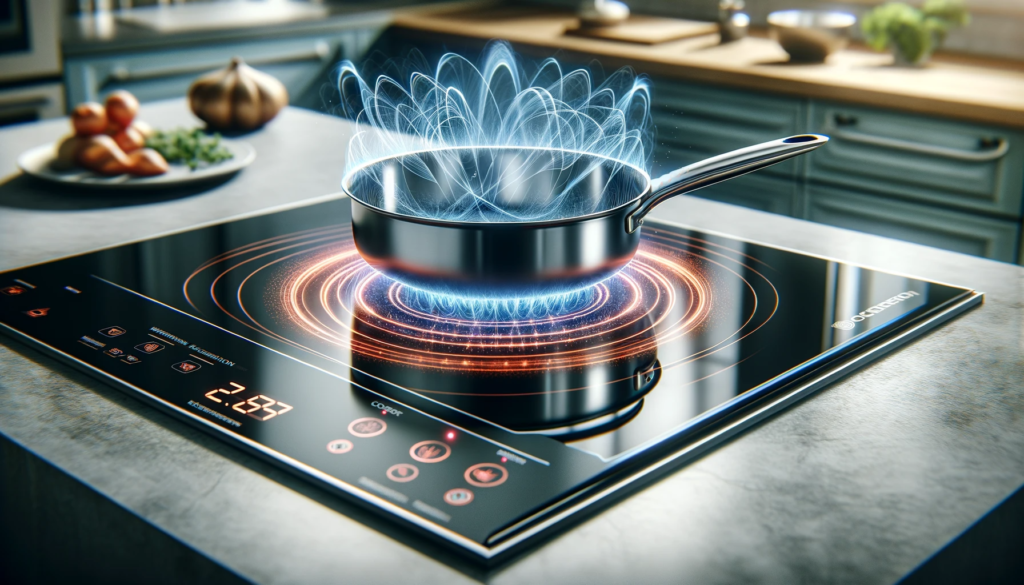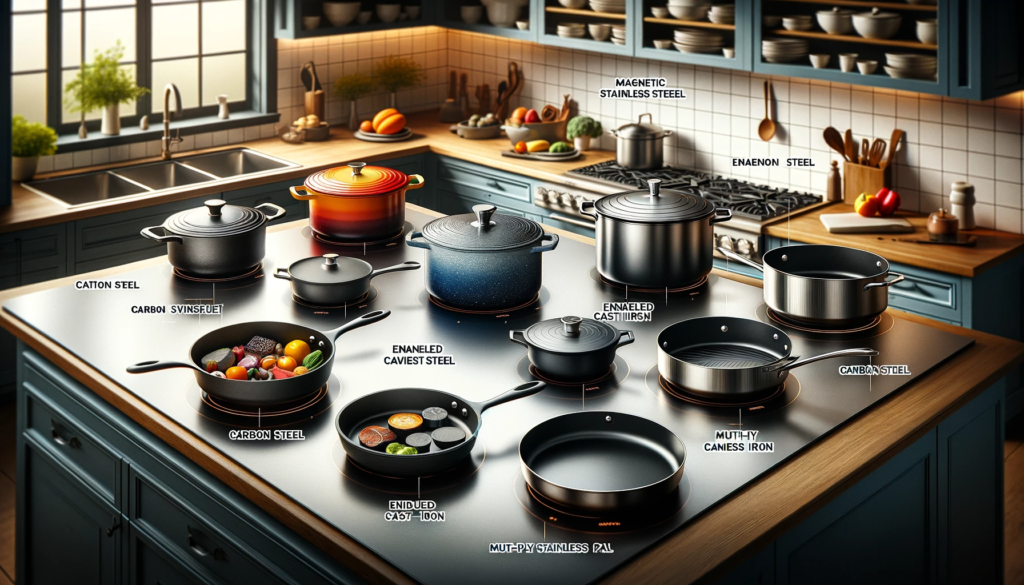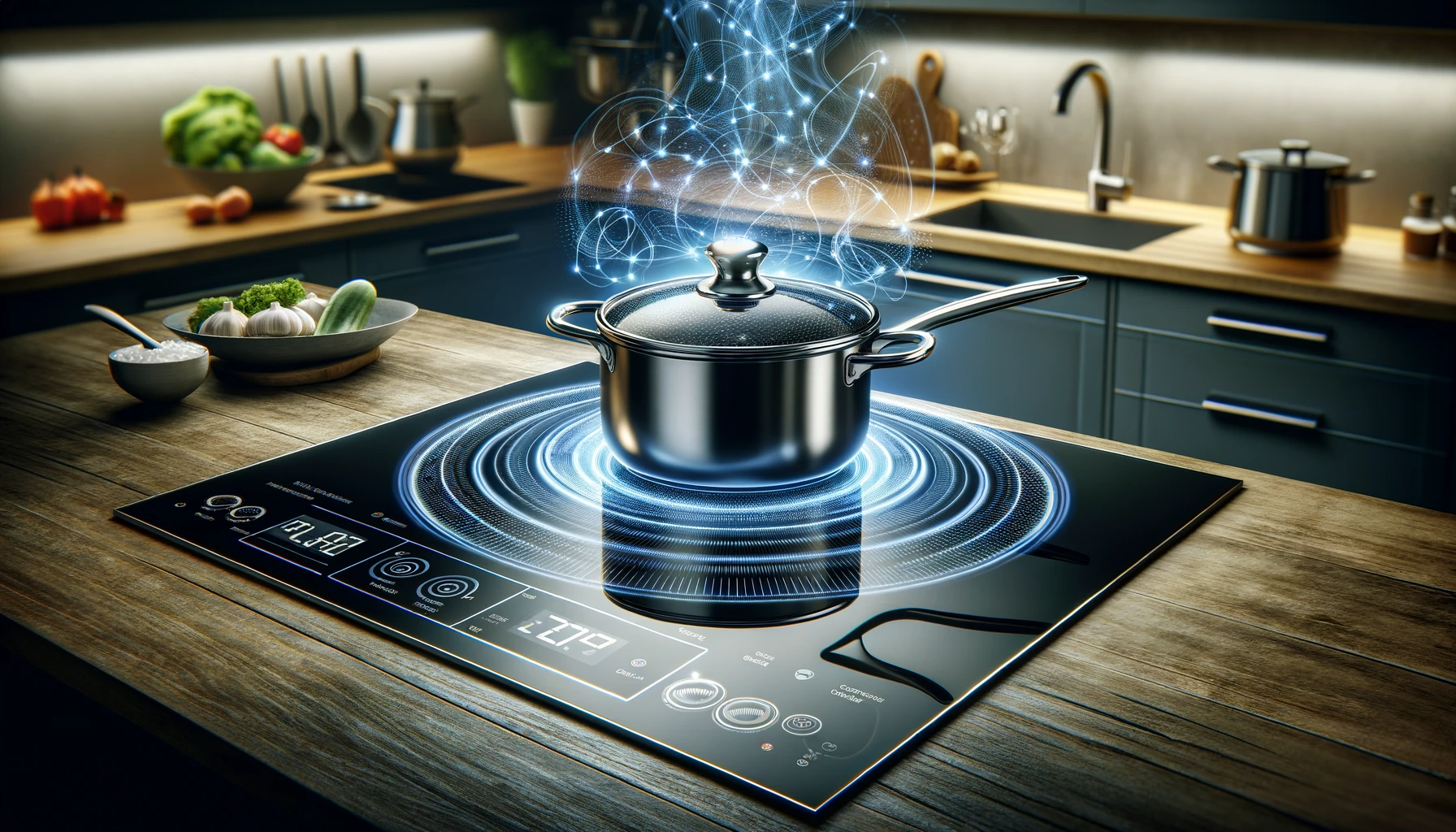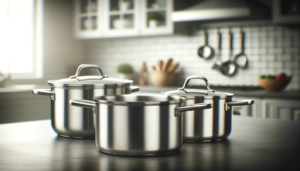Do your stainless steel pots and pans heat up properly on induction ranges or remain cold and unusable?
Induction cooking relies on magnetic properties that not all stainless steel cookware grades possess.
The induction compatibility of stainless steel pots and pans depends on the specific metal alloys used in their construction.
Magnetic stainless steel cookware containing enough iron and nickel content can leverage the precision heating of induction burners.
Let’s dive into understanding induction cooking, types of stainless steel that work on induction, how to identify compatible cookware and stainless steel’s merits and demerits versus other induction-safe cooking materials.
Can Stainless Steel Cookware Be Used on Induction Cooktops?

Yes, stainless steel cookware can be used on induction cooktops as long as it is a magnetic grade that contains iron and nickel.
Magnetic stainless steel alloys like 304 and 430 will heat up rapidly when in contact with an induction burner’s magnetic field.
Non-magnetic varieties of stainless steel that don’t have enough ferrous content will fail to generate heat on induction cooking zones.
Always check for induction compatibility ratings before purchasing stainless steel cookware if you plan to use it on an induction stovetop.
Do a magnet test to confirm pots and pans are magnetic.
What Is Induction Cooking?

Induction cooking relies on electromagnetic energy to heat pans directly instead of using flames or heating up a glass surface.
An induction cooktop contains copper coils that create a magnetic field when electric current passes through them.
When you place certain types of pans made with ferrous metals on top of the coils, the magnetic field induces a current in the pan, causing its molecules to vibrate rapidly.
This vibration generates heat directly in the pan itself.
Only pans that contain iron can work on an induction cooktop.
Copper, aluminum, glass and other non-ferrous pans do not get heated up.
This direct heating provides superior speed, efficiency and control compared to electric or gas stovetops.
There are no open flames or hot elements to burn or overheat food on an induction cooktop.
Heat is only generated when a compatible pan is in contact with the induction zone.
Once the pan is removed, the surface stops heating immediately.
This makes induction safer and easier to clean since no food, grease or liquids get baked onto the cooking surface over time.
You can precisely control cooking temperatures by adjusting the power level settings on an induction cooktop.
Induction zones also tend to have a very rapid boil due to the efficiency at which they transfer heat energy directly to the pan itself.
Induction cooking works by inducing electrical currents inside ferrous cookware placed on top of the glass surface.
When you turn on an induction burner, copper wire coils below the ceramic glass surface receive alternating electric current, which generates a fluctuating magnetic field.
Only cookware containing iron or steel interacts properly with this magnetic field.
When such pans come in contact with the induction top, the magnetic field penetrates the cookware and generates electrical eddy currents.
These electric currents meet electrical resistance within the pan material, producing rapid heat without heating the glass surface itself.
This efficient energy transfer makes induction burners heat up compatible cookware much faster compared to other cooking methods.
What Types of Stainless Steel Work with Induction?

While stainless steel is a popular cookware material, not all grades of stainless steel are compatible with induction cooking.
The key factor that determines induction compatibility is the presence of an electromagnetic conductive material like iron or nickel.
Stainless steel cookware made with alloys containing iron, nickel or both are capable of generating heat when exposed to an induction cooktop’s magnetic field.
These “magnetic” stainless steel pans will quickly become hot on an induction burner.
On the other hand, non-magnetic stainless steel grades contain low or no amounts of nickel or iron.
Instead, they consist mostly of chromium and other metals that do not interact properly with magnetic induction fields.
These non-magnetic stainless steels remain cool when placed on an induction zone.
Common magnetic stainless steel alloys suitable for induction cooking include 304, 430 and 434 stainless.
Popular non-magnetic alloys that won’t work on induction include 301 and 316 stainless.
The ability of stainless steel cookware to work on an induction cooktop depends on the specific metal alloys used in its construction.
Stainless steel is actually a generic name used for various steel alloys containing at least 10.5% chromium content.
The chromium provides excellent anti-corrosion properties.
But stainless steel containing just iron and chromium does not perform well for cooking.
So manufacturers add nickel, carbon, nitrogen, copper and other “austenite stabilizer” metals to enhance heat conduction and durability.
The exact combination of these additional metals determines induction compatibility.
Magnetic stainless steels contain enough nickel and iron to interact with magnetic induction fields.
Standard 304 grade used in kitchen tools, utensils and commercial cookware has excellent induction compatibility thanks to 8% nickel plus at least 50% iron content.
Budget-friendly 430 grade stainless with just iron and chromium also works on induction.
Popular non-magnetic 301 and 316 stainless have too little iron and nickel to heat up properly.
Checking alloy composition charts helps identify induction-suitable stainless steel cookware.
Identifying Magnetic Stainless Steel Cookware

The easiest way to figure out if your stainless steel pots and pans will work on an induction stove is to do a magnet test.
Simply hold a typical refrigerator magnet against the bottom outer surface of the pan.
If the magnet sticks strongly and does not slide off easily, your pan is made of a magnetic stainless steel suitable for induction cooking.
The magnet will weakly stick or completely fall off non-magnetic stainless steel cookware.
You can also check any ratings, symbols or indications printed on the packaging box or product tag.
Manufacturers will typically include an induction compatibility logo if the stainless steel pan can be used safely on induction cooktops.
Phrases like “for all stove types including induction” help identify induction-ready pans.
The packaging may also specify the grade of stainless steel like 430 or 304 stainless.
As mentioned earlier, 400 series stainless grades are magnetic while 300 series alloys are generally not induction compatible.
Finally, take a look at the stainless steel pan’s metal composition.
Magnetic stainless steel cookware will contain iron as well as a significant amount of nickel, usually between 8-10%.
Non-magnetic pans have less iron and nickel content.
Knowing the exact metals used can clarify induction suitability.
When purchasing new stainless steel cookware, carefully check all labeling, packaging symbols and fine print details mentioning induction readiness or cooktop compatibility.
Terms like “works with all stove types” help confirm the pans will heat up properly on induction burners.
Look for pertinent technical details on metal grade like 304 or 430 stainless steel which are magnet-friendly alloys.
If still unsure, do a quick fridge magnet stick test in the store itself to validate induction compatibility.
For existing stainless pans, hunt for grade markings stamped on the base or search online using the manufacturer name and product line for alloy information.
Using Stainless Steel Pans on Induction

Stainless steel cookware that passes the induction compatibility test offers great cooking experience on an induction cooktop.
You get fast, highly responsive heating that minimizes hot spots thanks to the cookware’s evenly spread iron and nickel content interacting with the induction field.
Stainless steel provides good thermal conductivity allowing cooks to rapidly adjust pan temperatures as needed during stove-to-oven cooking.
This metal is also hardy enough for high heat searing, stir frying or pressure cooking while being suitable for slow braising recipes as well.
When using any stainless pan on an induction burner, make sure to fully preheat it at medium to medium-high setting for a few minutes before adding cooking fat or food.
This gives the molecules enough time to start vibrating rapidly so the pan surface gets evenly hot.
Use a cooking oil with high smoke point when searing or frying to prevent burning and sticking.
Be prepared to adjust heat settings frequently to prevent scorching or undercooking the food.
Avoid scraping stainless steel cookware against the glass induction surface to prevent scratching.
And take care not to slide pots sideways while cooking as this can scratch both the pan and cooktop.
Compared to non-stick cookware, stainless steel pans are naturally sticky and prone to food residue baking on unless properly preheated before cooking.
Food release properties rely entirely on sufficient oil or fat layering the pan surface prior to adding ingredients.
Go easy on stainless steel abrasion even while deglazing or dislodging stuck bits to avoid scraping away the protective appearance layer.
Over time, the stainless develops darkened blotchy patches indicative of microscopic iron leaching out through microscopic pits and cracks.
This superficial cosmetic damage does not affect overall pan integrity or thermal performance.
But keeping heat low when cooking delicate egg-based batters or sauces helps minimize blotchiness over years of stove-to-oven usage.
Stainless Steel vs. Other Induction-Safe Options

While magnetic stainless steel sets work perfectly fine on induction ranges, they are not the only cookware materials that can leverage induction power.
Popular alternatives like enameled cast iron, carbon steel and multi-ply stainless lined pans are all induction compatible and have their own sets of advantages.
Cast iron Dutch ovens with enamel coatings provide exceptional heat retention and distribution.
This makes them ideal for slow braising, stewing and baking tasks.
But the extra weight and enamel fragility limits their usage for quick frying or tossing food.
Carbon steel pans match stainless steel’s fast heating but must be rigorously seasoned like cast iron to prevent rusting and reactivity.
Many high-end cookware lines also offer stainless steel sets with an induction-compatible steel or aluminum core sandwiched between stainless exterior and interior layers.
This tri-ply and multi-ply construction closely mimics professional-grade cookware for superior stability and responsiveness.
But these premium pans have a far steeper pricing than basic stainless sets.
Enameled cast iron pots and Dutch ovens with exterior enamel coating over bare cast interior offer unparalleled searing, browning and heat retention suited to all cooking techniques from raging boils to low simmering.
But the heavy heft and cumbersome footprint make maneuvering and cleaning tougher compared to lightweight stainless steel skillets.
Enamel coatings also chip and crack easily with sudden thermal shocks or clanging with metal utensils.
Carbon steel cookware resembles cast iron in needing extensive pre-seasoning to achieve non-stick properties.
Uncoated grayish-black carbon steel is highly reactive with acidic ingredients like tomatoes and vinegar.
But with proper initial curing and subsequent maintenance oiling after each wash, carbon steel delivers exceptional durability rivalling the very best stainless steel options.
Enthusiasts appreciate both metals for unrelenting heat conductivity across every stove type including induction.
Conclusion
Induction cooking offers faster, more energy-efficient, and safer cooking experience than traditional gas or electric ranges.
Stainless steel pots and pans containing enough iron and nickel heat up rapidly on induction cooktops.
While basic stainless steel cookware works well, consider supplementing with enameled cast iron or multi-ply sets for specific baking, braising and frying needs.
Evaluate your cooking style and requirements to invest in induction-compatible stainless steel and other metal cookware that best suits your needs.



